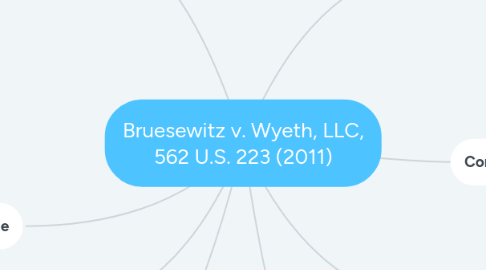
1. Facts
1.1. Parties
1.1.1. Parents of Hannah Bruesewitz (Russell and Robalee Bruesewitz)
1.1.2. Wyeth, LLC (the drug company)
1.2. What Happened
1.2.1. Two hours after Hannah Bruesewitz received her DPT (diphtheria, tetanus and pertusis) vaccine in 1992, she developed seizures and was hospitalized for weeks.
1.2.2. When Hannah was 3 years old, the parents filed petition seeking compensation for Hannah's injuries
1.2.2.1. 1 month before petition, new regulations eliminated seizure disorder from list of injuries that one can get compensated
1.2.2.2. Therefore, Petition was denied
1.2.3. Three years later in 1998, Wyeth drug company withdrew the specific type of vaccine used on Hannah from the market
1.3. Procedural History
1.3.1. The Bruesewitzes filed lawsuit against Wyeth in state court in Pennsylvania
1.3.1.1. Claimed the drug company failed to develop safer vaccine and should be held accountable for preventable injuries
1.3.2. Wyeth removed the lawsuit to the Federal District Court
1.3.3. Third Circuit Court Appeals affirmed
2. Issue
2.1. Can a federal law protect vaccine manufacturers from product liability lawsuits that is due to serious health damages suffered by children after product use?
3. Rule of Law
3.1. National Childhood Vaccine Injury Act (NCVIA) of 1986 created protection for vaccine manufacturer to stabilize the vaccine market. The Act eliminates manufacturer liability if vaccines end up causing unavoidable side effects.
4. Importance
4.1. As a business professional, investing in vaccine manufacturer is a safer bet knowing that the NCVIA protects the manufacturers from manufacturer liability due to unavoidable side effects.
5. Analysis/Application
5.1. Plaintiff
5.1.1. Bruesewitz alleged that defective design of the DPT vaccine caused Hannah's disabilities
5.1.2. Claimed that Drug Manufacturer was subject to strict liability under the Pennsylvania Law
5.2. Defendant
5.2.1. NCVIA gives immunity from civil liabilities for unavoidable side-effects.
5.3. Court
5.3.1. Any side-effects including design defects are deemed unavoidable
5.3.2. Enforced intent of Congress
5.3.2.1. Overall, there is a public health benefit to vaccine and manufacturers need to be protected against liabilities.
6. Conclusion
6.1. The NCVIA protects the vaccine manufacturers from all lawsuits by plaintiffs seeking compensation for injury or death caused by a vaccine's side effects.
7. Impact
7.1. Sebelius v. Cloer, 569 U.S. 369 (2013)
7.1.1. Dr. Melissa Cloer was vaccinated for Hepatitis B in 1996 and 1997 and developed symptoms of multiple sclerosis.
7.1.2. Several years later, Dr. Cloer sued under NCVIA but was unsuccessful and dismissed as untimely and did not meet the requirements.
7.2. Barcal v. EMD Serono (2016)
7.2.1. Plaintiff's claim of design defect of fertility drug is preemptive since FDA approved the formulation of the drug.

